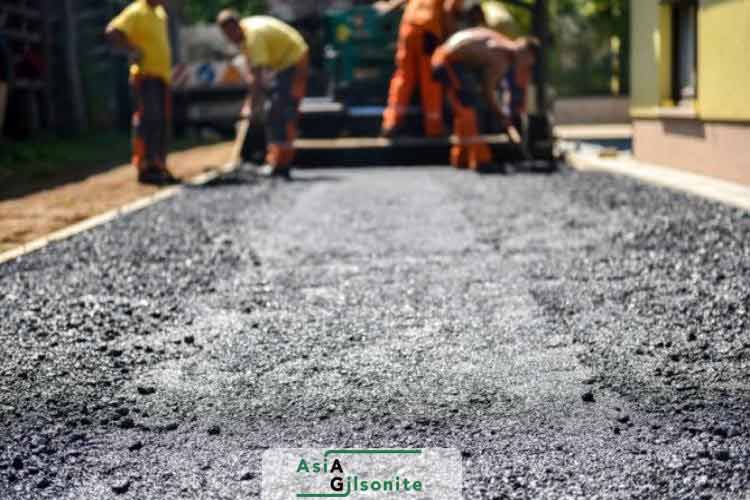Paving asphalt is a versatile and cost-effective material used in the construction of roads, parking lots, and driveways. The process of paving with asphalt is complex and requires careful planning and execution to ensure a high-quality end result. In this article, we will discuss the asphalt paving process and the steps involved in this procedure.
The Chemical Properties of Paving Asphalt
Paving asphalt is a complex mixture of hydrocarbons, which have various chemical properties that contribute to its performance as a paving material. Some of the key chemical properties of asphalt sulfonated include:
Viscosity
Asphalt paving has a high viscosity, which means it resists flow and deformation under stress. This property is important for maintaining the shape of a road surface under the weight of vehicles.
Softening point
Asphalt softens as it is heated, and the softening point is the temperature at which it becomes soft enough to deform under load. This property is important for ensuring that the asphalt remains stable under high temperatures during the summer months and during the asphalt paving process.
Penetration
Asphalt’s penetration is a measure of its ability to penetrate into a porous surface such as a road base. High penetration is desirable for ensuring good adhesion to the road base.
Ductility
Asphalt has good ductility, meaning it can be stretched without breaking, which is important for resisting cracking or rutting.
Chemical Stability
Chemically, asphalt can resist oxidation, ultraviolet light, and other environmental factors that can cause it to degrade over time.
Asphaltene content
To better understand the asphalt paving process you should know that asphalt contains a significant amount of asphaltenes, which are complex, high-molecular-weight molecules that contribute to its strength, durability, and viscosity.
Asphalt Paving Production Process
Before heading to the steps of paving asphalt, getting to know the production process of the asphalt itself can be of importance. The production process of paving asphalt typically involves the following steps:
Refining
Crude oil is first heated and distilled in a separation tower to separate different fractions of hydrocarbons. In the fraction containing bitumen, a thick, viscous material, is collected.
Blending
Different grades of bitumen are blended together to meet specific specifications for making it ready for the asphalt paving process. Other materials such as polymers, additives, and solvents may also be added at this stage to improve durability, workability, and performance.
Heating and Mixing
The bitumen blend is heated in large tanks to a high temperature, then mixed with aggregates such as crushed limestone or gravel. The ratio of bitumen to aggregates is carefully controlled to ensure the resulting paving asphalt meets the desired specifications.
Testing
The finished asphalt sulfonated is tested in a laboratory to ensure it meets the desired performance characteristics such as viscosity, softening point, and penetration.
Transportation
The asphalt paving is loaded into tanker trucks and transported to paving sites, where it is laid and compacted to form roads, parking lots, and other surfaces.
Asphalt Paving Steps
The asphalt paving process and steps involve precision and expertise. Here are the steps for paving asphalt:
Step 1: Preparation of the Surface
The surface on which the asphalt is to be laid must first be cleared of any obstructions and debris and graded to create a smooth surface. The sub-base also should be prepared. The sub-base is the foundation layer of the pavement and must be stable, flat, and properly compacted to support the weight of the asphalt.
Step 2: Base Layer Installation
Once the surface is ready, a layer of crushed stones and gravel is laid to create a stable foundation for the asphalt layer. Typically, a layer of aggregate is placed over the sub-base. In this step of the asphalt paving process, the base layer is then compacted to even it out and ensure that it is firm. Proper compaction of the base layer is crucial to ensure a smooth and durable surface.
Step 3: Asphalt Mixture Preparation
The asphalt mixture is prepared in an asphalt plant, where aggregates such as crushed stone, sand, or gravel are mixed with a binder, typically asphalt cement or liquid asphalt. The exact composition and proportions of the mixture will depend on factors such as temperature, traffic volume, and site conditions. This step also involves heating the asphalt to a temperature suitable for spreading and application. Other ingredients, such as sand, are added to the asphalt to increase its durability.
Step 4: Spreading of Asphalt
The prepared asphalt is poured onto the base layer using a paving machine and spread out evenly across the surface. The paving machine then compacts the asphalt to ensure it adheres to the base layer.
Step 5: Compaction of Asphalt
After the asphalt layer is spread out and leveled, a roller is used to ensure that the surface is smooth and compact. This helps to remove any air pockets or problems that could otherwise reduce the quality of the finished surface.
Step 6: Finishing
The final step in the asphalt paving process is the application of a sealant or surface treatment. This can help to extend the life of the pavement by protecting it from water, UV radiation, and other environmental factors. Additionally, line striping and other markings may be added to the pavement to facilitate traffic flow and improve safety.
Why Is Asphalt Paving Important
Asphalt paving is important for several reasons:
Smooth and Safe Surfaces
Asphalt provides a smooth and even surface, making it easier and safer for drivers, cyclists, and pedestrians to travel on roads, walkways, and parking lots.
Durability
The asphalt paving process is important because it’s a durable material that can withstand heavy traffic, harsh weather conditions, and other environmental factors, making it a long-lasting and cost-effective choice for road and pavement construction.
Easy Maintenance
Asphalt pavements are easy to maintain and repair, requiring minimal downtime and less cost of maintenance compared to other paving materials.
Environmental Benefits
Asphalt is 100% recyclable, reducing landfill waste while also conserving energy during the asphalt production process.
Economic Benefits
Paving asphalt provides economic benefits by reducing vehicle maintenance costs and improving fuel efficiency, which translates to significant savings over time.
Conclusion
In general, the asphalt paving process involves several important steps and processes, from site preparation to final touches. Proper planning, preparation, and execution are key to achieving a high-quality end result that is durable, long-lasting, and able to withstand the demands of heavy traffic and harsh weather conditions. Overall, asphalt paving plays a vital role in the development and maintenance of our roads, public spaces, and transportation systems, making it a critical component of modern-day infrastructure.







Asphalt paving has more steps than my morning routine—who knew? 😂 Love how this breaks it down! Now, if only fixing life’s rough patches was as straightforward as smoothing out a road. Maybe I just need a steamroller for my problems… or at least a good cup of coffee! ☕